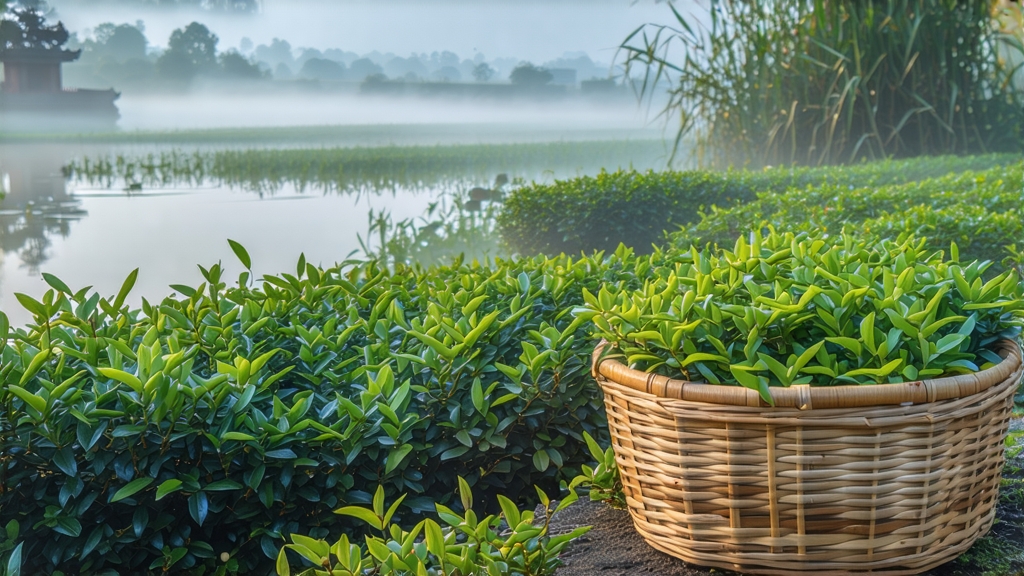
Biluochun, whose name literally means “Green Snail Spring,” is one of China’s ten most celebrated teas, yet it remains a delicate secret outside serious tea circles. Grown on the mist-locked islands and peninsulas of East China’s Taihu Lake, this tiny spiral of jade is prized for a fragrance so intense that, when first shipped to the imperial court in 1699, the Kangxi Emperor renamed it from the humbler “Xia Sha Ren Xiang” (“Scary Fragrance”) to the more elegant “Biluochun.” The renaming myth is only the beginning of a story that weaves together geology, botany, craftsmanship, and centuries of Jiangnan poetry.
History and Terroir
The tea’s homeland lies in Dongting Mountain, actually two hills—Dongshan and Xishan—rising from Taihu’s vast freshwater surface. Limestone ridges trap morning mist, creating a natural shade that slows photosynthesis and concentrates amino acids in the bud. The lake itself moderates temperature, so winters are mild and springs arrive early. Local fruit trees—peach, plum, apricot, and loquat—intercrop with tea bushes, their blossoms falling like snow onto the rows, lending a subtle floral note that connoisseurs swear they can taste. First written records appear in the Tang Dynasty (618-907), but Biluochun’s fame crystallized during the late Ming when Suzhou scholars, already intoxicated by the city’s gardens and opera, began to celebrate its “liquor like distilled dew.”
Cultivar Spectrum
Although the name is protected by national origin standards, three related cultivars dominate:
- Dongting Small-Leaf群体种—an old seed-grown landrace with tiny, thick leaves that tolerate lake humidity.
- Fuding Dabaicha—introduced in the 1970s for higher yield, yet still capable of forming the signature tight spiral when handled by skilled hands.
- Wuniuzao (“Crow’s Beak Early”), a 1990s bred clone that flushes ten days ahead of the landrace, extending the harvest window. Each cultivar expresses different aromatics: landrace leans toward orchid and snap pea; Dabaicha toward sweet corn; Wuniuzao toward fresh bamboo shoot.
Plucking Code
The picking calendar is brutally short. Only the bud and the immediate sub-leaf (a “sparrow’s tongue”) are taken, before 10 a.m., when moisture is still evaporating. One kilo of finished tea needs roughly 70,000 plucks—about six hours of skilled labor. Experienced pickers use a twisting motion that bruises the stem just enough to start enzymatic oxidation, yet keeps the bud intact for later rolling.
Crafting the Spiral
Within four hours of plaching, leaves reach the village workshop where three masteries—killing-green, rolling, and drying—are compressed into a fifteen-minute ballet performed at 180 °C.
- Shaqing (kill-green): A cast-iron pan, brushed with Dongting spring water, is heated to 200 °C. The tea master tosses 250 g of buds in a clockwise arc, using only the heel of the palm to avoid breaking the tips. In 3–4 minutes leaf temperature reaches 85 °C, deactivating polyphenol oxidase and locking in the vivid jade color.
- Cuotuan (initial rolling): Immediately the heat drops to 120 °C. Fingers form a loose cage around the leaves, rolling them against the pan in a spiral motion. The goal is to rupture 30 % of cell walls without visible breakage, releasing fragrant lactones and ionones that evoke peach and jasmine.
- Tanliang (re-drying): Finally the temperature falls to 70 °C. The master lifts the leaves high, letting them fall like green rain so residual moisture escapes. When moisture reaches 6 %, the leaf has shrunk into a downy curl no larger than a paperclip, yet still hides a silver tip.
Sensory Lexicon
Dry leaf aroma is explosive: a blend of lychee, watercress, and steamed edamame. Upon brewing, the liquor glows pale chartreuse. Top notes are snap pea and white peach; mid-palate reveals a marine salinity reminiscent of Taihu’s breeze; the finish is sweet, almost like Chinese wintermelon candy, with a returning coolness (huigan) that lingers on the edges of the tongue. Professional cuppers look for “three greens”—green